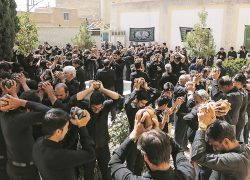Archive Rituals and Festive Events

Ta'ziyeh Dramas of Khomeyni Shahr:
A Tragedy Series
The ta’ziyeh dramas of Khomeyni Shahr are among the most spectacular ta’ziyeh performances in Isfahan Province, especially for photographers and tourists.

Music of the Bakhshis of Khorasan:
Legendary Musical Heritage
In Khorasan Province, the Bakhshis are renowned for their musical skill with the dotār, a two-stringed, long-necked lute.

The Ritual of Jeghjegheh-Zani in Abyaneh:
A Wooden Orchestra
The ritual of jeghjegheh-zani is held on Tasu’a morning, in the villages of Abyaneh and Tareh and some other villages of Natanz County.

The Ritual of Sang-Zani in Shahreza:
Grieving Stones
The Bani Assad Congregation, known as the Sang-Zan-ha, is a well-established religious group in Shahreza, which performs its unique ritual in this city from one day before Tasu’a (Muharram 9) until the 13th day of Muharram.

The Ritual of Hoom Babaei:
Children’s Myths of Ramadan
Nowadays, this belief has become a tradition, and on this night, a number of children, teenagers, and young people, called the Hoom Babaei group, go to the doors of houses after iftar and ask for help for the people in need.

The Traditional Ritual of Jirjirouni in Dastjerd Village:
The Proof of the Pudding Is in the Eating
The 27th of Ramadan is the best time to visit Dastjerd Village in Jarqavieh Olya District, which is located in the southeast of Isfahan, and participate in the Jirjirouni Ceremony.

A Muharram Ritual in Kashan:
Hexagon on the Shoulders
When it comes to the Muharram rituals of Kashan, the sixth day of Muharram is dedicated to carrying the hexagon.

The Ritual of Zanjir-Zani in Rehnan:
Mourners’ March in Rehnan
Rehnan is a historical district in the western part of Isfahan City. It is at a distance of about 10 km from the center of the city.

Naqqāli, Iranian Dramatic Story-Telling:
The Oldest Dramatic Performance
Naqqāli is the oldest form of dramatic performance in the Islamic Republic of Iran and has long played an important role in society, from the courts to the villages.

The Ritual of Cooking Samanou in Shahreza:
Winter’s Charity
Cooking samanou in Shahreza is more common in winter, on the nights of the death or birth anniversaries of the Imams, and in the last week of the year for the Nowruz table.

A Rainmaking Ritual in Azaran Village, Kashan County:
Staring at the Sky
Having disappeared in most parts of Iran, the celebration of Abrizan (Tirgan) is still breathing in a valley named Abderaz, which stretches on the slopes of Mount Chal-Azaran, the second highest mountain of Kashan.

Wedding Traditions in Isfahan:
The Brides of Isfahan
Women of the boy’s family choose a girl for him and then go to her family’s house in order to meet the girl and become more familiar with each other.









